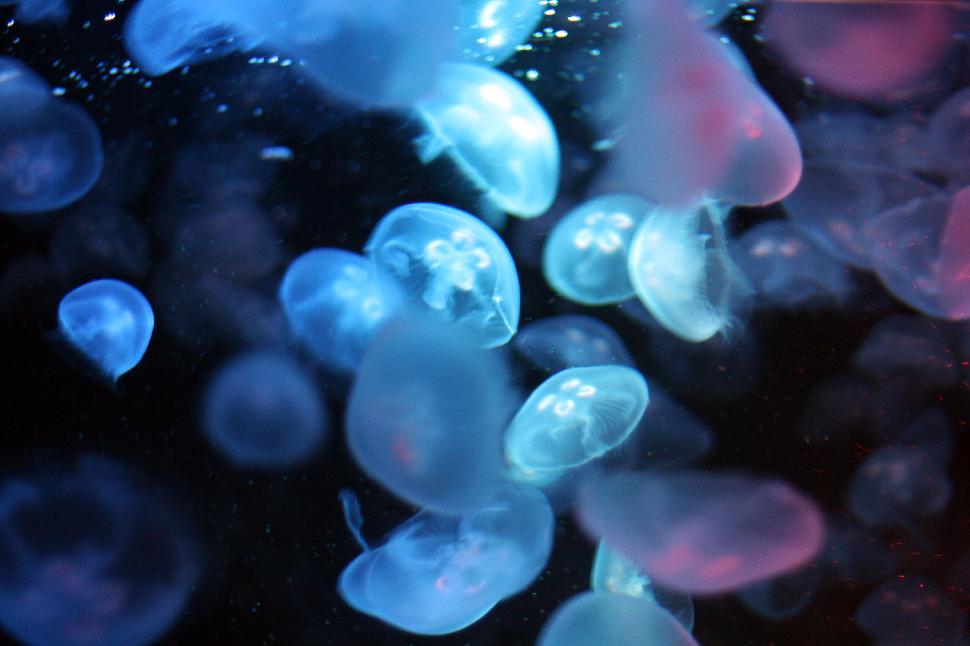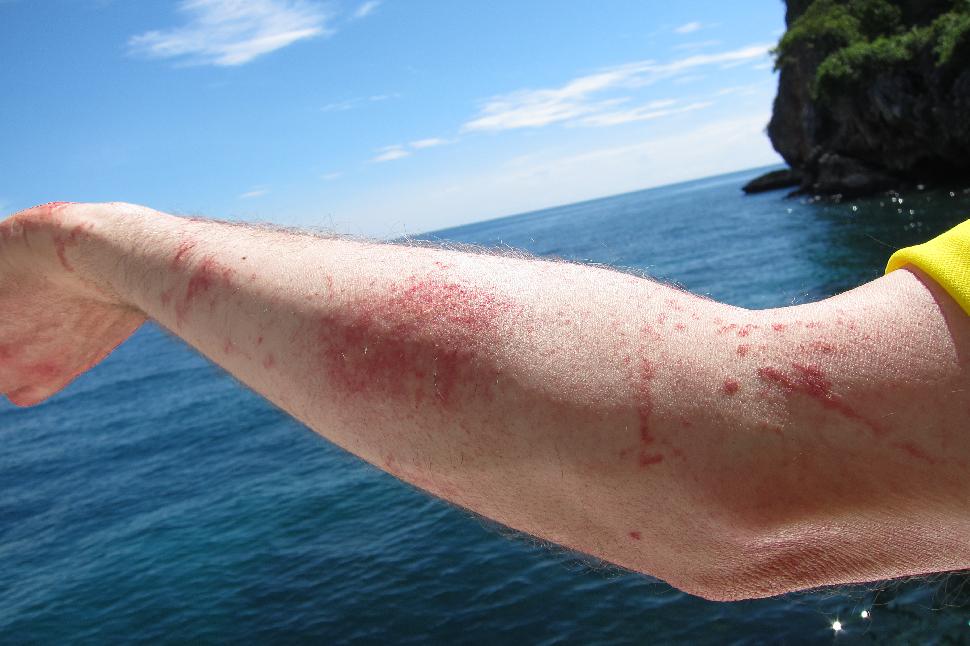You’ve seen them, those sad gelatinous blobs washed up on the beach. Out of their ocean environment, jellyfish don’t look like much. Yet these simple invertebrates—without brains, bones, or hearts—are full of surprises.
Jellies have survived in our seas virtually unchanged since Precambrian times. That’s more than 300 million years before the first dinosaurs.
“They give us a glimpse back in time to what it was like a billion years ago,” says University of Victoria lecturer Roswitha Marx.
Today, jellies are in virtually every ocean, and range in size from thimbles to inflatable pools. Of an estimated 1,500 to 2,000 species in the world, British Columbia has about 75. Jellyfish belong to the phylum Cnidaria in the classes Hydrozoa and Scyphozoa, though the term “jellyfish” is commonly applied to other aquatic jelly-like creatures.
Jellies can be startling to encounter underwater (especially when it comes to their stingers). Some B.C. species look like UFOs, others like weird mushrooms, caterpillars, and cracked eggs. One jelly, the typically 30- to 40-metre Praya species, may be the world’s longest living animal; another, Ptychogastria polaris, resembles a miniature bowl of intestines. It’s a cast of characters to rival the strangest science fiction.
They Hunt
The jellyfish diet includes zooplankton, small fish, and other jellies. When food is scarce, says Marx, these aquatic critters can survive simply by absorbing amino acids from the ocean. But most of the time, they capture prey with specialized, one-time-use stingers called nematocysts or cnidocysts.
Each of a jelly’s thousands, perhaps millions, of nematocysts consists of a coiled, microscopic thread—often tipped with a barb—which shoots out like a harpoon in response to chemical or physical stimuli.
The nematocysts of some jellies—including the variety that sting humans—inject paralyzing toxins. Others merely spiral around to entangle the prey. Threads of mucous are used in conjuction with the nematocysts to trap food, which the jelly then draws into its mouth with its tentacles.
B.C.’s folded-stomach jelly, Ptychogastria polaris, attaches itself to the seafloor with its short, adhesive tentacles, and nabs passing prey with its longer, outer tentacles. The tailed jelly, or Nanomia bijuga, stretches out its full length—at least 30 centimetres—and trails its tentacles along like fishing lines until dinner floats by.
They Glow

Aequorea Victoria, the water jelly common to B.C., is best known for its ability to produce bioluminescence. When this jellyfish is agitated, the lower rim of its bell-shaped body glows green—an effect caused by the interaction of two proteins known as aequorin and green fluorescent protein (GFP).
Japanese scientist Osamu Shimomura discovered how to extract GFP from water jellies he collected at Washington State’s Friday Harbor Laboratories in the 1960s. Later researchers purified and cloned the molecule.
“Aequorea is probably the most important jellyfish in the world,” speculates biologist Claudia Mills of Friday Harbor.
Scientists use GFP today to track proteins in living cells. Under UV light, the molecule fluoresces green. As one researcher describes it, GFP is “the microscope of the 21st century.”
Recent GFP research ranges from remarkable to downright bizarre. An American biotechnology company generated a mouse that fluoresces green under blue light and implanted it with red-fluorescing cancer cells so researchers can observe the cancer’s growth. A research team in England produced fluorescent-green testicles on male mosquitoes, allowing for males to be separated from females and sterilized to reduce the spread of malaria. The National Taiwan University recently bioengineered three glow-in-the-dark pigs. And, in 2000, a Chicago artist commissioned a fluorescent rabbit for a living art exhibit.
About one-third of B.C.’s jellies are bioluminescent, says Mills, though no one knows for sure what advantage they get from glowing. “It’s probably used as a scare response.”
They Regenerate
Healthy jellyfish, if damaged, have the ability to re-grow small amounts of tissue, such as a tentacle or two. Parts of the Praya species—a creature that looks like some sort of alien caterpillar—can even detach and survive on their own for weeks or more.
But the regeneration prize goes to the polyp stage of the jellyfish lifecycle. If a growing polyp is severed in two, each half will re-grow its missing parts, resulting in two complete polyps.
Perhaps most versatile is the hydra, a freshwater polyp with no known jellyfish stage. In recent experiments, scientists have pressed hydra through mesh and found that, remarkably, the animals reassembled to their original form.
“These amazing animals consist of two cell layers only?one on the outside, one on the inside,” says Vancouver Island researcher Roswitha Marx. “It pays, if you’re going to be that fragile, to have the ability to regenerate.”
Here’s a quick run-down on where polyps fit into the jelly lifecycle. An adult male releases sperm into the water current; the sperm enters an adult female and fertilization occurs. Small planulae larvae leave the female and swim off to attach themselves to rock or other substrate, where they metamorphose into polyps; these polyps bud to produce ephyrae, which grow in a stack and are released one at a time. The ephyrae develop into juvenile jellyfish, and finally into adult medusae.
They Jiggle
The jiggling mass of a typical jelly is 96 percent water, 3 percent protein, and 1 percent minerals. Most of that protein is collagen, also the most common protein in the human body and an essential building material in our connective tissue and cartilage. Unfortunately for jellyfish, people have taken note.
Authors of “Jellyfish as food” in the Netherlands’ journal Hydrobiologia report that jellyfish proteins have long been hailed as a cure for arthritis, hypertension, back pain, and ulcers. They are also thought to soften skin, improve digestion, combat fatigue, and ease swelling.
“In Korea,” the writers note, “jellyfish are promoted on television and in women’s magazines as an aid for weight loss and beautiful skin.” Few of the health claims involving jelly collagen have been supported by science, though new research conducted at the University of Wisconsin-Milwaukee suggests that jellyfish proteins show promise as a treatment for Alzheimer’s and other degenerative diseases.
They Cruise
With the exception of stalked jellies, which live mostly sedentary lives attached to rocks, eel grass, and shells, adult jellies spend much of their time getting knocked around by currents and tides. One species, though, Velella velella, actually harnesses the wind to direct its travels. Technically a floating hydroid, the by-the-wind sailor is a blue-rimmed, rather plastic-looking disk. It floats on the water’s surface and catches air with its half-moon “sail,” allowing it to change directions and cruise at a faster clip than its cousins.
Not that other jellies are strictly aimless drifters. Many with the classic “umbrella” or bell shape can employ a kind of jet propulsion. By expanding its body, the jelly takes in water; when it contracts, the water is expelled, thrusting the creature in the opposite direction.
The moon jelly, Aurelia labiata, has further refined its locomotion, using the sun as a compass. Researchers at Vancouver Island’s Saanich Inlet found that their study population migrates from mid-morning to late afternoon in a southeast direction and congregates at one side of the inlet—behaviour thought to aid in reproduction.
They Taste . . . good?
If you have a hankering for a low-fat, low-calorie snack with little flavour but lots of crunch, jellyfish might be the food for you. Salted jellyfish has been a delicacy for more than 1,000 years in China, the first of several countries that now process edible jellies.
Washington biologist Claudia Mills estimates that as many as 85 species are fit for human consumption, though only 15 or so make their way into the international market. None of these edible species are found in B.C.
“Our jellies would dry down to just a thin sheet of nothing,” Mills explains.
Your best chance of finding jellies on a B.C. menu is to visit a local Asian restaurant, where the “meat” likely will be dressed with sauce or served with vegetables in a salad. Or, pick up a package of shredded jellyfish from an Asian market and try your hand at Jellyfish cuisine:
Try this Jellyfish Recipe:
- 1 lb dried jellyfish
- ½ tsp sesame oil
- 1 tsp wine
- ¼ tsp white pepper
- 3 tsp oyster sauce
Soak dried jellyfish in cold water for six hours. Rinse and pat dry with a towel. Mix jellyfish together with all other ingredients for a unique appetizer.
Humans aren’t the only ones feasting on jellies—so do some fish, including chum and dogfish, leatherback turtles, and other jellies.
They Sting

You’re out for a summer swim, splashing in the brisk Pacific waves when, suddenly, OUCH! You’ve roamed into the tentacles of a jellyfish. Most B.C. jellies are gentler than their tropical kin, administering just a slight sting to humans or none at all. But a few others, such as the lion’s mane, Cyanea capillata, can deliver a wallop that’ll leave you moaning for hours. Luckily, none of B.C.’s species are lethal to people under normal circumstances.
So, what to do if you’re stung? First, head ashore to avoid drowning. Now, the tricky part. Theories and myths abound as to which remedy provides the best relief. The BC HealthGuide (www.bchealthguide.org) recommends using a vinegar compress on the area to deactivate any cells still stuck to your skin, preventing additional stings. Unseasoned meat tenderizer, which breaks down protein, or baking soda—either sprinkled directly onto the skin or mixed into a paste with water—can help. So can flushing the area with large amounts of seawater, or applying a compress of quarter-strength household ammonia. Do not use fresh water or rubbing alcohol, as these liquids can trigger any remaining nematocysts. Urine, gasoline, kerosene, and turpentine aren’t recommended, either.
After the stingers have been neutralized, they can be picked or scraped off using a stick, towel, or glove. Or lather the area with shaving cream, soap, or a paste of baking soda, flour, or talc, and shave off the cells with a razor or plastic credit card. An antihistamine and hydrocortisone cream or ice pack may help control itching and pain.
Where to go Looking for Jellyfish
Hang around any sheltered bay or inlet along British Columbia’s coast on a spring or summer day just before high tide and chances are good you’ll spot at least one or two jellyfish. They often congregate under docks and floats—B.C. Ferries terminals are good places to look. Other jellyfish hot spots include: Saanich Inlet near Victoria on Vancouver Island; Indian Arm, near Deep Cove on the Lower Mainland; Pender Harbour, Sechelt and Narrows inlets near Sechelt on the Sunshine Coast.
B.C.’s most commonly spotted jellies include moon, water, by-the-wind sailor, lion’s mane, and fried egg jellyfish, Phacellophora camtschatica. The Vancouver Aquarium (604-659-3474; www.vanaqua.org) keeps water and sea nettle jellies, Chrysaora fuscescens, as well as the tropical spotted jelly, and features a live display of the moon jelly lifecycle.
Info
Marine Life of the Pacific Northwest by Andy Lamb and Bernard P. Hanby (Harbour Publishing, 2005).
Claudia E. Mills (http://faculty.washington.edu/~cemills). Website of the Washington-based jellyfish researcher.
Race Rocks (www.racerocks.com) Click “Video Archives” and “Invertebrates” to access jellyfish video footage.

